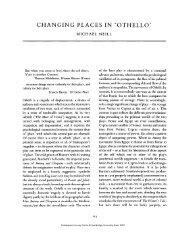the individualization of shakespeare's characters through imagery
the individualization of shakespeare's characters through imagery
the individualization of shakespeare's characters through imagery
You also want an ePaper? Increase the reach of your titles
YUMPU automatically turns print PDFs into web optimized ePapers that Google loves.
INDIVIDUALIZATION OF SHAKESPEARE'S CHARACTERS<br />
compasses" (m, iv, 72). He invokes <strong>the</strong> "chaste stars" (v, ii, 2). To kill Desdemona means "to<br />
put out <strong>the</strong> light" (v, ii, 7). The lamp he holds in his hand is a "flaming minister" (v, ii, 8). To<br />
kill Desdemona is to pluck <strong>the</strong> rose (v, ii, 13), to kiss her as she sleeps is to smell <strong>the</strong> rose on <strong>the</strong><br />
tree (v, ii, 18). Had Desdemona been true to him he would not have sold her for a world made<br />
"<strong>of</strong> one entire and perfect chrysolite" (v, ii, 143). Desdemona's skin is whiter "than snow, and<br />
smooth as monumental alabaster" (v, ii, 4). Instead <strong>of</strong> saying that he is a man already advanced<br />
in years, O<strong>the</strong>llo says that he is "declined into <strong>the</strong> vale <strong>of</strong> years" (m, iii, 266). He compares<br />
Desdemona to a hawk (m, iii, 265) and to <strong>the</strong> fountain from which his current runs (iv, ii, 58).<br />
Instead <strong>of</strong> simply vowing "by heaven", he says much more picturesquely "by yond marble<br />
heaven", with marble probably used as a synonym for enduring, constant, inviolable. He calls<br />
patience a "young and rose-lipt cherubin" (iv, ii, 62). Learning, after her death, that Desdemona<br />
was innocent, O<strong>the</strong>llo weeps tears <strong>of</strong> joy and compares his tears with <strong>the</strong> "medicinable gum" <strong>of</strong><br />
"<strong>the</strong> Arabian trees" (v, ii, 349). After Desdemona's death he compares himself with "<strong>the</strong> base<br />
Indian", who "threw a pearl away richer than all his tribe" (v, ii, 346). Contemplating death<br />
he speaks <strong>of</strong> <strong>the</strong> "very sea-mark <strong>of</strong> my utmost sail" (v, ii, 267). The following images, too, it<br />
seems, should be classed as poetic. O<strong>the</strong>llo compares his heart to a stone: he strikes his breast and<br />
it hurts his hand (rv, i, 181). The image <strong>of</strong> a heart turned to stone recurs in O<strong>the</strong>llo's speeches:<br />
"thou dost stone my heart", he tells Desdemona (v, ii, 63). O<strong>the</strong>llo tells <strong>the</strong> Senators that<br />
custom "hath made <strong>the</strong> flinty and steel couch <strong>of</strong> war my thrice-driven bed <strong>of</strong> down" (1, iii, 231).<br />
Thus, l<strong>of</strong>ty and poetic images are abundant in O<strong>the</strong>llo's speech. The epi<strong>the</strong>t poetic is particularly<br />
appropriate to <strong>the</strong>m. Some <strong>of</strong> <strong>the</strong>m are full <strong>of</strong> Oriental atmosphere: <strong>the</strong> moon, <strong>the</strong> " two<br />
hundred compasses" <strong>of</strong> <strong>the</strong> sun, <strong>the</strong> fragrance <strong>of</strong> roses, a world <strong>of</strong> chrysolite, skin as white as<br />
alabaster. The gum <strong>of</strong> Arabian trees and <strong>the</strong> Indian with his pearl are frankly exotic. Investigators<br />
who refuse to admit exotic colour in O<strong>the</strong>llo's role are <strong>the</strong>refore in <strong>the</strong> wrong.<br />
The numerous classical images he uses are also <strong>of</strong> <strong>the</strong> l<strong>of</strong>ty and poetic type. He speaks, for<br />
instance, <strong>of</strong> <strong>the</strong> "light-wing'd toys <strong>of</strong> fea<strong>the</strong>r'd Cupid" (1, iii, 268). Waves are "hills <strong>of</strong> seas<br />
Olympus-high" (n, i, 191). Thunder is "th' Immortal Jove's dread clamours" (m, iii, 356).<br />
Desdemona's name was, according to O<strong>the</strong>llo, "as fresh as Dian's visage" (in, iii, 388). He<br />
compares his feelings with <strong>the</strong> Pontic (Black) sea which flows ever forward (m, iii, 453). He<br />
calls life "Prome<strong>the</strong>an heat" (v, ii, 12). The image <strong>of</strong> chaos in <strong>the</strong> famous phrase "when I love<br />
<strong>the</strong>e not, Chaos is come again" (m, iii, 92) is also to be regarded as classical. Finally, <strong>the</strong> image <strong>of</strong><br />
a personified justice evoked by <strong>the</strong> words: "O balmy breath, that dost almost persuade Justice<br />
to break her sword" (v, ii, 16), may also be included here. Justice is allegorically pictured as a<br />
feminine figure carrying a sword.<br />
L<strong>of</strong>ty, poetic and solemn <strong>imagery</strong> is so abundant and so essential in O<strong>the</strong>llo's role that we are<br />
quite justified in calling it <strong>the</strong> dominant <strong>the</strong>me in his world <strong>of</strong> images. However, it is not <strong>the</strong><br />
only <strong>the</strong>me. In sharp contrast to it <strong>the</strong>re is ano<strong>the</strong>r <strong>the</strong>me represented by a whole group <strong>of</strong><br />
images which may be called low.<br />
O<strong>the</strong>llo calls a suspicious, jealous man a 'goat' (ni, iii, 180). "Goats and monkeys!" he<br />
exclaims in a fit <strong>of</strong> jealousy (iv, i, 264). 8 He says he "had ra<strong>the</strong>r be a toad, and live upon <strong>the</strong><br />
vapour <strong>of</strong> a dungeon" than be cuckolded (m, iii, 270). He compares Desdemona to "a cistern<br />
for foul toads to knot and gender in" (iv, ii, 60). He commands his bosom to swell with its<br />
"fraught, for 'tis <strong>of</strong> aspics' tongues" (m, iii, 451). Desdemona's singing, he says, is capable <strong>of</strong><br />
85<br />
Shakespeare Survey Online © Cambridge University Press, 2007



